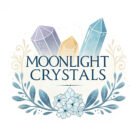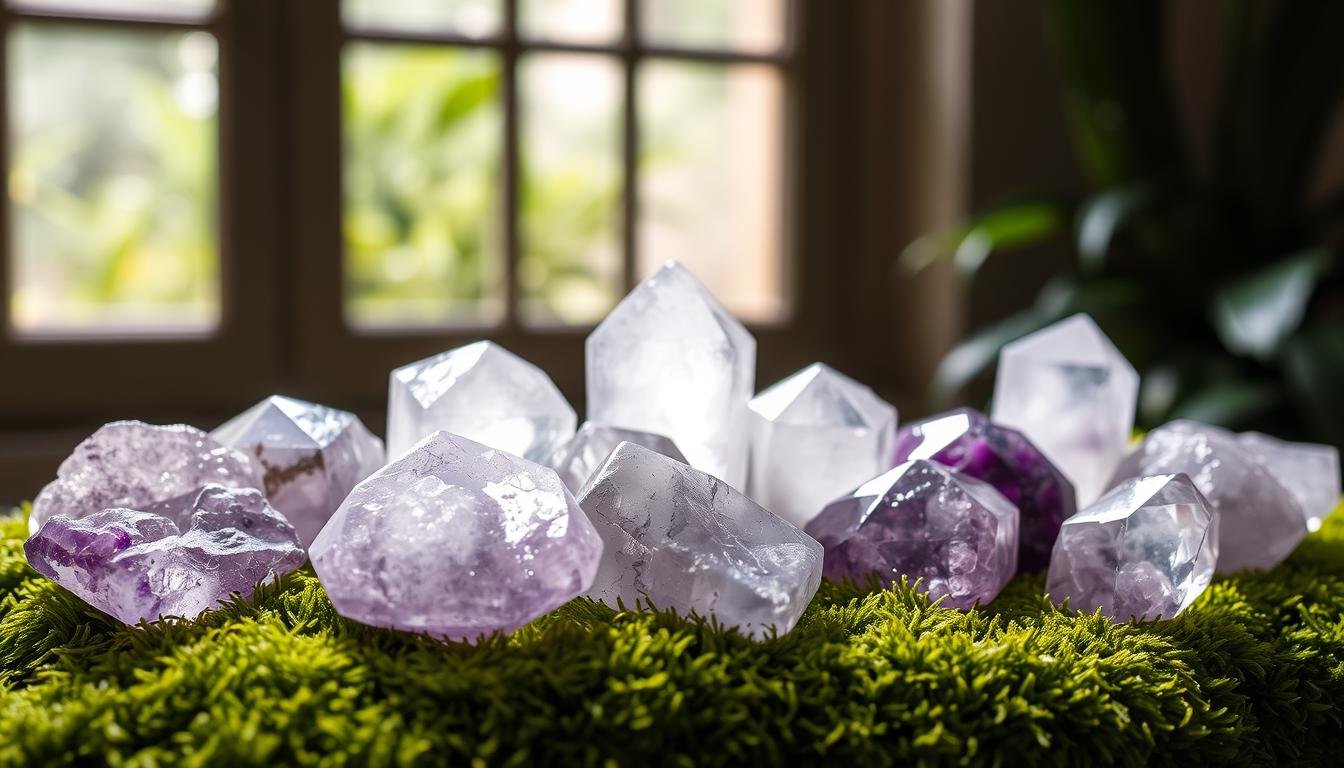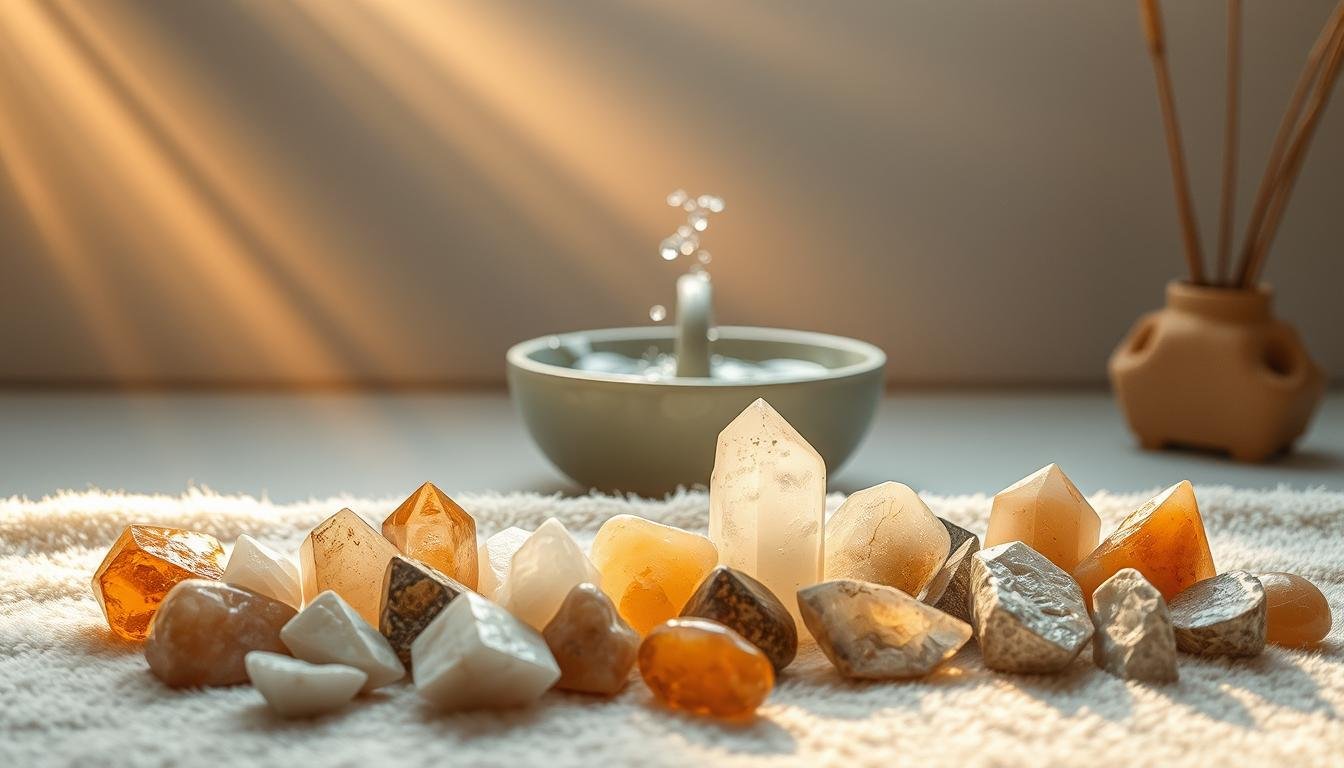Choosing the right stones for water cleansing is essential to maintain their energy and physical integrity. Not all stones are created equal, and understanding their properties can prevent damage or loss of their natural beauty.
The Mohs hardness scale is a key factor in determining which stones are safe for use in water. Stones with a rating of 6 or higher are generally durable enough to withstand water exposure. However, exceptions exist, especially for those containing iron or copper, which can rust or dissolve.
This article provides a clear guide to help you identify safe and unsafe options. Whether you’re new to using stones or a seasoned enthusiast, this information ensures your collection remains vibrant and effective.
Understanding the Role of Water in Crystal Cleansing
Water cleansing is a simple yet powerful method to rejuvenate your gemstones. It’s widely used for its ability to refresh and renew the energy of stones. However, not all stones are suited for this method, and understanding the benefits and risks is crucial.
The Benefits of Water Cleansing Your Gems
Water is a natural cleanser that helps remove stagnant energy from stones. It’s particularly effective for stones like quartz and amethyst, which thrive in water. These stones often see their healing properties amplified after a cleanse.
Using water to cleanse crystal collections is also convenient. It’s accessible and doesn’t require special tools. Many enthusiasts find it a quick way to maintain their stones’ vibrancy.
Recognising the Risks Involved
While water cleansing is popular, it’s not without risks. Softer stones or those with toxic elements can be damaged. For example, stones containing iron or copper may rust or dissolve in water.
Even some water safe stones, like carnelian and agate, should only be cleansed in freshwater. Saltwater can harm their structure. Always research your stones before using water.
| Safe Stones | Unsafe Stones |
|---|---|
| Quartz | Malachite |
| Amethyst | Selenite |
| Carnelian | Fluorite |
| Agate | Azurite |
The Science Behind the Mohs Hardness Scale
The Mohs hardness scale is a fundamental tool for understanding mineral durability. Developed in 1812 by Friedrich Mohs, it ranks minerals from 1 (talc) to 10 (diamond) based on their ability to scratch one another. This scale is essential for determining which stones can withstand water exposure.

How to Interpret the Scale
The Mohs hardness scale is not linear. Each number represents a mineral’s scratch resistance. For example, talc (1) is easily scratched by a fingernail, while diamond (10) can cut glass. Minerals like quartz (7) and topaz (8) fall in the middle, offering moderate durability.
Here’s a quick guide to interpreting the scale:
- 1-3: Soft minerals (e.g., talc, gypsum).
- 4-6: Medium hardness (e.g., fluorite, orthoclase).
- 7-10: Hard minerals (e.g., quartz, diamond).
Why Hardness Dictates Water Safety
A mineral’s hardness directly impacts its water compatibility. Stones rated 6 or higher on the Mohs hardness scale are generally safe for water use. For instance, quartz and amethyst are durable enough to withstand water exposure without damage.
However, softer minerals like calcite (3) or fluorite (4) can dissolve or degrade in water. This is why understanding the scale is crucial for maintaining your collection’s integrity.
“The Mohs hardness scale is a simple yet effective way to gauge a mineral’s durability.”
| Mineral | Mohs Hardness | Water Safety |
|---|---|---|
| Talc | 1 | Unsafe |
| Quartz | 7 | Safe |
| Diamond | 10 | Safe |
Which Crystals Can Go in Water
The quartz family stands out as a reliable choice for water cleansing due to its durability. These gemstones are not only visually stunning but also highly resistant to water damage. Their sturdy composition makes them ideal for both cleansing rituals and elixir making.
Safe Quartz Family Crystals and More
Clear quartz and rose quartz are among the most popular stones in the quartz family. Their high rating on the Mohs hardness scale ensures they can withstand water exposure without losing their natural beauty. These stones are also known for amplifying healing properties when cleansed with water.
Amethyst, another member of the quartz family, is equally durable. Its vibrant purple hue remains intact even after prolonged water exposure. These stones are perfect for those looking to maintain their collection’s energy and vibrancy.
Recognising Extra Durable Stones
Beyond the quartz family, stones like tiger eye are also safe for water use. Known for its striking bands of colour, tiger eye is a durable gemstone that retains its structure even when submerged. Its grounding energy makes it a favourite among enthusiasts.
When identifying water-safe gemstones, look for those with a Mohs hardness rating of 6 or higher. These stones are less likely to dissolve or degrade in water. Their physical characteristics, such as smooth surfaces and vibrant colours, often indicate their durability.
| Safe Gemstones | Mohs Hardness |
|---|---|
| Clear Quartz | 7 |
| Rose Quartz | 7 |
| Amethyst | 7 |
| Tiger Eye | 6.5 |
By choosing these durable stones, you can ensure your collection remains vibrant and effective. Their inherent energy is preserved, making them a valuable addition to any cleansing ritual.
Crystals That Should Never Touch Water
Not all gemstones are designed to handle water exposure, and some can suffer irreversible damage. While water cleansing is a popular method, it’s essential to recognise which stones are unsuitable for this practice. Certain stones, due to their softness or chemical composition, can dissolve, rust, or release toxic elements when submerged.
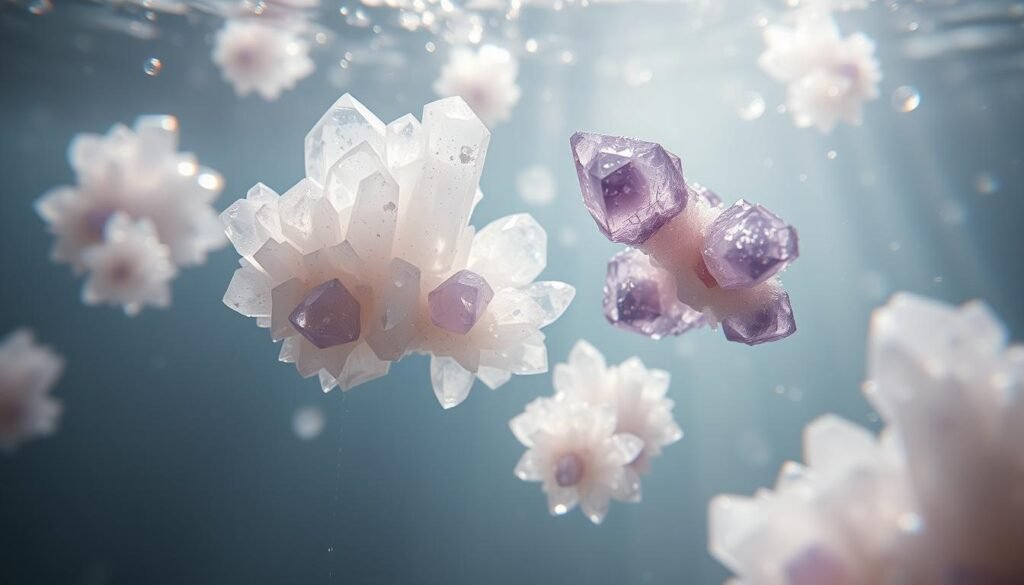
Identifying Water-Sensitive Stones
Stones like selenite and fluorite are particularly vulnerable to water. Selenite, with a Mohs hardness of 2, can dissolve even in brief contact with water. Fluorite, though slightly harder, is prone to cracking and losing its lustre when exposed to moisture.
Other examples include:
- Hematite: Contains iron, which can rust when submerged.
- Malachite: Releases toxic fumes when exposed to water.
- Calcite: Dissolves easily due to its soft structure.
Understanding the Hazards of Toxic Elements
Some stones contain elements like copper or iron, which react negatively with water. For instance, hematite rusts, while malachite can release harmful substances. Even short durations in water can cause irreversible damage to these stones.
Salt water poses additional risks. Stones like fluorite and labradorite can lose their structural integrity when exposed to salt water. Their chemical composition makes them highly sensitive to such environments.
“Water exposure can turn a beautiful stone into a damaged or even hazardous object.”
Always research your stones before using water for cleansing. Their physical and chemical properties determine their compatibility with water. By avoiding water-sensitive stones, you can preserve their beauty and energy for years to come.
Why Some Crystals Are Water-Sensitive
Understanding the chemical makeup of gemstones is key to determining their compatibility with water. Certain stones contain elements that react negatively when exposed to moisture, making them unsuitable for water cleansing. This section explores the reasons behind their sensitivity and how to care for them properly.
Chemical Composition and Elemental Concerns
The elemental structure of a stone plays a significant role in its reaction to water. Stones containing copper, iron, or lead are particularly vulnerable. These elements can rust, dissolve, or release toxic substances when submerged, posing risks to both the stone and the user.
For example, hematite contains iron, which rusts in water. Similarly, malachite releases harmful fumes when exposed to moisture. These reactions highlight the importance of understanding a stone’s chemical properties before using water for cleansing.
Examples of Water-Sensitive Stones
Here are some stones that should never be exposed to water due to their chemical composition:
- Selenite: Dissolves quickly in water due to its soft structure.
- Fluorite: Prone to cracking and losing its lustre when wet.
- Calcite: Easily dissolves in water, even in brief contact.
These stones are not only fragile but can also release harmful substances. Their sensitivity underscores the need for alternative cleansing methods.
Why Some Stones Are Considered Crystal Safe
Stones like quartz and amethyst are considered crystal safe because of their durable structure. They lack harmful elements and can withstand water exposure without damage. Their high rating on the Mohs hardness scale further ensures their compatibility with water.
When choosing stones for water cleansing, always consider their chemical makeup and hardness. This ensures their healing properties remain intact and their physical beauty is preserved.
| Water-Safe Stones | Water-Sensitive Stones |
|---|---|
| Quartz | Selenite |
| Amethyst | Fluorite |
| Carnelian | Calcite |
By understanding the chemical properties of your stones, you can ensure they remain vibrant and effective. Always research before using water to cleanse your collection.
Alternative Methods for Crystal Cleansing
Exploring alternative cleansing methods ensures your stones remain vibrant and effective. Not all gemstones can handle water exposure, but there are other ways to maintain their energy. These techniques are gentle and safe, especially for delicate stones.

Moonlight and Sunlight Charging Techniques
Moonlight and sunlight are natural ways to cleanse and recharge your stones. Placing them under the full moon overnight is a popular method. This works well for stones like moonstone, which thrive in lunar energy.
Sunlight is another option, but use it cautiously. Some stones, like amethyst, can fade in direct sunlight. A short exposure time is often enough to refresh their energy.
Smudging and Sound Healing Approaches
Smudging involves using smoke from herbs like sage or palo santo to cleanse stones. Pass your stones through the smoke while setting an intention. This is a quick and effective way to remove stagnant energy.
Sound healing uses vibrations from singing bowls or tuning forks. The sound waves help reset the stone’s energy. This method is ideal for fragile stones that can’t handle physical contact.
| Method | Best For |
|---|---|
| Moonlight Charging | Moonstone, Selenite |
| Sunlight Charging | Clear Quartz, Citrine |
| Smudging | All Stones |
| Sound Healing | Delicate Stones |
These alternative methods are safe and effective for maintaining your collection’s energy. They offer a gentle way to keep your stones vibrant without risking damage.
Caring for Your Crystals: Tips for Long-Lasting Energy
Maintaining the vibrancy and energy of your stones requires consistent care and attention. Whether you’re a seasoned enthusiast or just starting, these tips will help keep your collection in top condition.
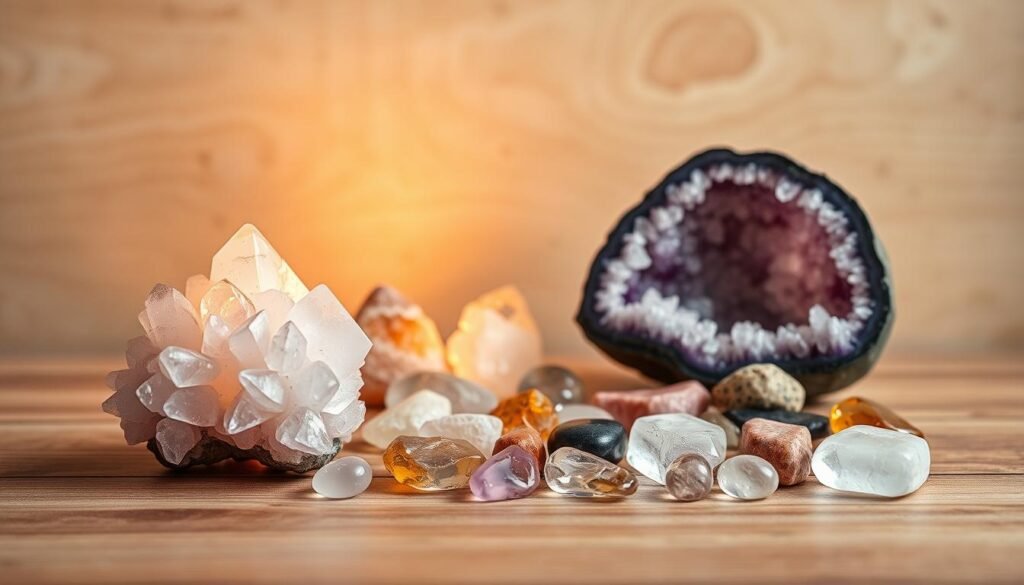
Here’s a list of best practices to ensure your stones remain vibrant and effective:
- Clean Regularly: Use alternative methods like smudging or sound healing to avoid water damage. This keeps your stones water safe and preserves their natural beauty.
- Recharge Frequently: Place your stones under moonlight or sunlight to refresh their energy. Moonlight is particularly effective for delicate stones like selenite.
- Store Properly: Keep your stones in a clean, dry place to prevent scratches or exposure to harmful elements.
Understanding the importance of keeping your stones water safe is crucial. Avoid submerging stones that are prone to damage, and opt for alternative cleansing techniques instead.
Periodically recharging your stones ensures their energy remains strong. Methods like placing them on cleansing stones or using sound vibrations can be highly effective.
By following these tips, you can maintain the healing properties and physical integrity of your collection. Consistent care ensures your stones stay vibrant and effective for years to come.
Tips for Making Your Own Crystal Water Elixirs
Creating crystal water elixirs is a unique way to harness the energy of gemstones. These elixirs can enhance your well-being, focus, and emotional balance. However, it’s essential to choose the right stones and follow safety guidelines to avoid toxicity.
Selecting Truly Water-Safe Gems
Not all stones are suitable for direct water infusion. Safe options include citrine, amethyst, jasper, and rose quartz. These stones are durable and free from harmful elements that could leach into the water.
Always avoid using salt water with sensitive stones, as it can damage their structure. Research each stone’s properties before use to ensure it’s safe for elixir preparation.
A Step-by-Step Guide for Elixir Preparation
Follow these steps to create your own crystal water elixir safely:
- Choose Your Stone: Select a water-safe gemstone like citrine or rose quartz.
- Clean the Stone: Use a soft cloth to remove any dirt or debris.
- Place in Water: Submerge the stone in filtered water for 4-6 hours.
- Set an Intention: Focus on the energy you want the elixir to carry.
- Store Properly: Transfer the elixir to a glass container and refrigerate.

For added safety, consider the indirect method. Place the stone in a glass bowl and set it inside a larger container of water. This allows the energy to transfer without direct contact.
Here’s a quick list of stones to avoid in elixirs:
- Selenite: Dissolves in water.
- Malachite: Releases toxic substances.
- Fluorite: Prone to cracking.
By following these guidelines, you can create powerful and safe crystal water elixirs. These elixirs are a wonderful way to incorporate the healing energy of gemstones into your daily routine.
Parting Thoughts on Crystal Care and Water Purity
Proper care ensures your gemstones retain their natural beauty and healing properties. Matching cleansing methods to stone type is essential for maintaining their energy and physical integrity. Stones like amethyst, tiger eye, and citrine thrive when handled correctly.
Water purity plays a vital role in preserving the energy of your collection. Always use safe water and avoid salt for sensitive stones like fluorite and labradorite. These techniques ensure your stones remain vibrant and effective.
Explore further resources and expert guides to deepen your understanding. Share your experiences and treat each gemstone as a unique element in your collection. Commitment to crystal safe practices ensures long-term health and vitality.
